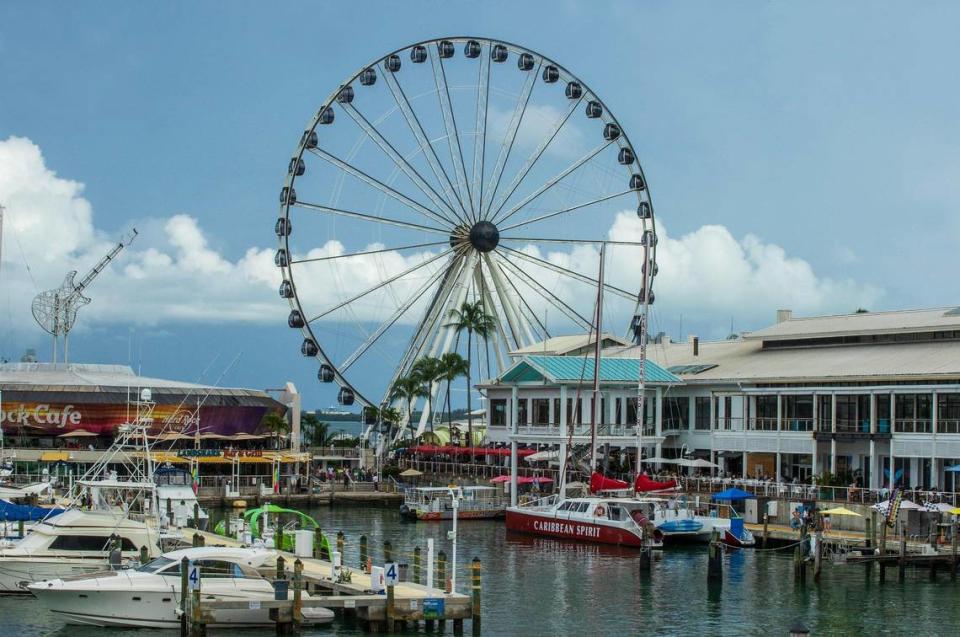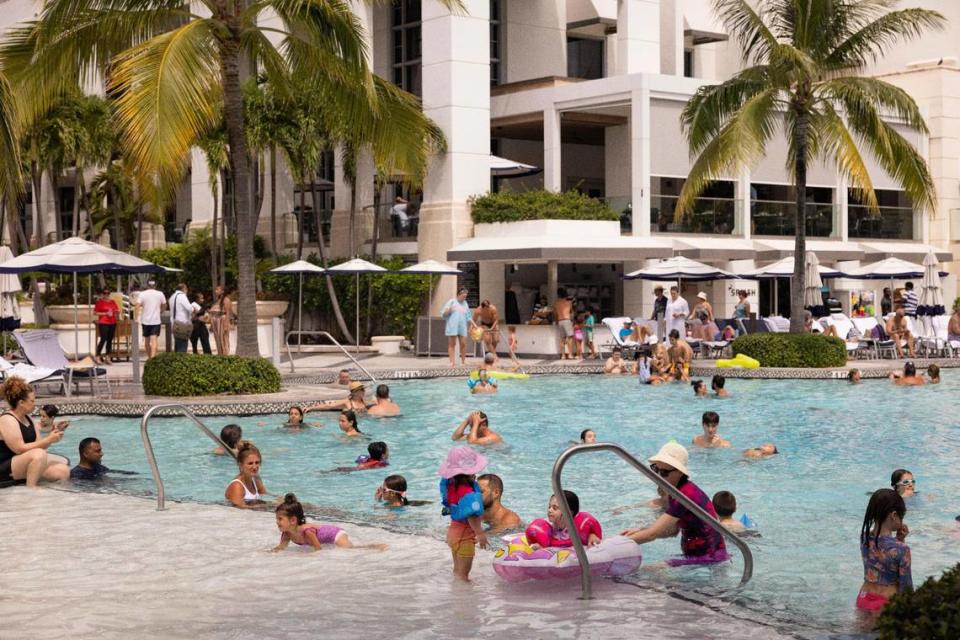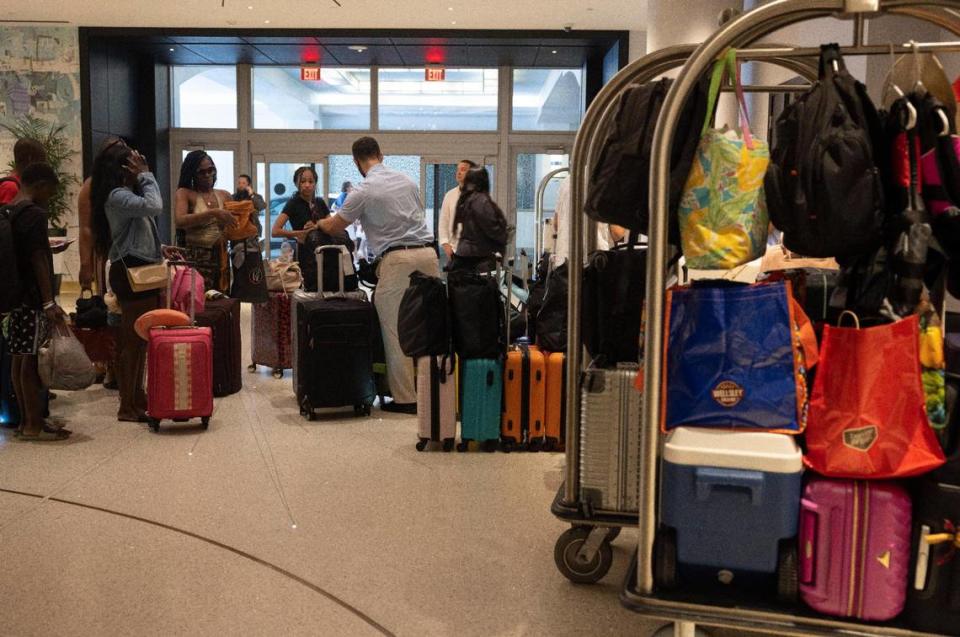‘Florida fatigue’ slows South Florida tourism this year, after pandemic breakout
David Berbon, a 25-year-old architecture student in Munich, Germany, walked along Collins Avenue in South Beach on a recent weekend, taking in its wonders for the first time. He and a friend had been in Chicago for their university’s exchange program, and had time to visit one more city before returning home.
They picked Miami over Cancun because “we just wanted the palms and beach,” Berbon said. Plus, “we heard a lot of good stories about Miami.”
It only took a few days, however, to see more than palm trees and South Beach. Although they enjoyed themselves, the student friends from Germany got plenty of sticker shock from the prices of hotel rooms, food, drinks and more.
“They’re crazy high,” Berbon lamented of Miami’s prices, noting he paid $12 for a beer at a bar that would have cost him $4 in Germany.
Because of the steep prices on seemingly everything, he was hesitant when asked whether he’d make a return trip to Miami. Indeed, the Miami-Fort Lauderdale-West Palm Beach metropolitan area is leading big cities nationwide with a 9% jump in consumer prices during the 12 months that ended in April, according the U.S. Bureau of Labor Statistics. That inflation level is more than twice the national average, according to the Consumer Price Index of 4%.
Berbon’s reaction to Miami’s steep prices should concern area tourism officials, because he’s not alone with that sentiment. After three strong pandemic years when business flourished for South Florida’s critical tourism industry because this area was one of few destinations in the world that essentially kept beaches and other visitor attractions open, travelers have many other places to go in the United States, Europe, Asia and the Caribbean for vacations this year.
Miami and Fort Lauderdale tourism marketing leaders got the proof recently in the form of an array of visitor measures for the first half of 2023. The erosion of tourism business was apparent, particularly at hotels. While total number of tourists visiting Miami-Dade County from January through June rose by 1% to 12.4 million, visitors from the United States dropped by 6% to 6.6 million, according to data from the Greater Miami Convention and Visitors Bureau.
Some U.S. travelers this year have been experiencing “Florida fatigue,” said Peter Ricci, associate professor and director of hospitality management systems at Florida Atlantic University in Boca Raton. “They have been to Florida two or three times in the past five years, so they’re a little fatigued on Florida.”
That was quite evident in the hospitality industry in Miami-Dade, according to interviews with industry analysts, hotel executives, tourism officials, and a review of data. Hotel occupancy, average daily overnight rate, and revenue per available hotel room each declined in the first half of 2023 compared with the same six-month period the prior year.
Daryl Cronk, director of southeastern U.S. hospitality analytics for CoStar, a national provider of financial information and commercial real estate analytics, said compared to last year “hotel performance has softened some in South Florida.”
Miami-Dade’s average hotel occupancy rate this year through June was 75%, a 1.4% annual decrease, according to CoStar’s data. The average daily hotel overnight rate was $249, a 5.8% drop, while average revenue per hotel room fell 7.1% to $186.81. Among the largest 25 American cities, Miami-Dade’s percent change in hotel costs and revenue per room each ranked last, and the hotel occupancy fluctuation ranked second to last.
By comparison, first-half average hotel occupancy was 75.8% in the greater Fort Lauderdale area, a slight annual increase of one-half of 1%. The area’s average daily hotel room rate was $210.54, up 2.3%, while revenue per room was $159.55, a 2.8% jump, according to CoStar’s data.
But those Broward County hotel figures really tell two stories, a strong first three months followed by declines in the following three months of spring and early summer ending June 30, said Stacy Ritter, CEO of Visit Lauderdale, the county’s tourism marketing agency.
The same dynamic occurred in Miami-Dade, when this winter brought a strong visitor rebound compared to the first quarter of 2022 that was devastated by the omicron variant of the coronavirus that kept many would-be tourists home, tourism and hotel analysts said.
“We had no competition for 2020, 2021, and a lot of 2022,” Ritter said of South Florida. Now, “the traveler has more choices and can pick and choose what works best with the budget.”
During the pandemic, tourists headed to beaches because they were outdoors. With stimulus funds flowing and consumers saving extra money, many of those who took trips chose Miami, Fort Lauderdale, Orlando or somewhere in the Sunshine State.
“All of that helped pump up Florida’s tourism industry,” Cronk said. Now, “we’re seeing a little bit of that normalizing this year.”
Miami hotel prices fall
Meanwhile, at Bayside Marketplace in downtown Miami on a recent evening, Eric Sevenier, 58, his wife Chrystel, 54, and their 18-year-old son Guilhem walked past shops, seafood restaurants, the Hard Rock Cafe and were waiting in line to check out the Skyviews observation ferris wheel.
They drove to Miami from New York, after flying there from their home in Marseilles, France. Sevenier wanted his son to see New York and Miami. Miami is “the place in the U.S. we feel the friendliest atmosphere,” he said.
Yet, Sevenier also was taken aback by the prices of food and hotels in Miami, noting they made the city almost as pricey as New York. He thought the obvious inflation in Miami could deter some European tourists from visiting.

During the pandemic, Miami-Dade hotels had pushed hard on hotel prices, seeking to take advantage of travelers’ demand for rooms. Indicating that was CoStar’s data that showed the county’s average daily hotel rate of $264.31 for the first six months of 2022 was a 21% jump from the same period in 2019 before the public health crisis emerged.
Now hoteliers are admitting they are struggling to hold the price growth they had gained when tourists who visited Miami had far fewer vacation choices.
“People are not willing to pay the rates that they were paying last year,” said Mutluhan Kucuk, managing director of Loews Miami Beach Hotel.
That Loews property is one example of a local hotel that has seen occupancy and revenue per room decline in the first half of 2023. Therefore, the hotel lowered its overnight rate. In July, summer travel boosted the hotel’s occupancy to 90%, Kucuk said, and so this month overnight rates went back over $300.
“This year was particularly challenging for hoteliers because everybody wants to improve year-over-year but it’s so hard to improve from a record-breaking year,” the Loews executive said, referring to 2022. “Things sometimes level off, and this is the year we’re seeing that.”
Thankfully, Miami-area hotels have plenty of loyal visitors who come annually or make multiple trips a year, often to escape colder climates. Walter Nieves and his family are a prime example.
Around noon earlier this month under a glaring sun, Nieves, 48, relaxed shirtless on his chair on the swimming pool deck at the Loews hotel in Miami Beach. He, his wife, Diana, and son, Vincent, were visiting from their home in Lyndhurst, New Jersey. They come down to South Florida three to four times a year, he said, partly because his wife has family here.
“We figured we’d come down here and enjoy the weather before my son starts school,” said Nieves, and “before we get back to the grind up north.”
When they vacation, it’s either Miami or Puerto Rico for the Nieves family. “Me and my wife are creatures of habit,” he said. “We like to know where we’re going to eat and what we’re going to do.”
Cruise, airline traffic resurging
The resurgent cruise industry is helping Miami’s tourism sector. Total number of cruise passengers departing from PortMiami through July surpassed 6 million, closing in on the 2019 passenger total of 6.8 million, port officials said. The port’s fiscal year runs from October to September.
But prior to the pandemic many cruise travelers would spend up to six nights in one of South Florida’s three counties — Miami-Dade, Broward or Palm Beach — before or after their cruises, FAU tourism professor Ricci said. Now, they typically only stay here on land for one or two nights, he said.
Another encouraging sign for tourism operators in the second half of this year is the increased traffic at Miami International Airport through June 30. The airport had 26.2 million passengers arriving here during the first six month of the year, a 2.6% increase from the same period last year. At midyear, foreign visitor arrivals were up 12% and domestic traveler arrivals were down nearly 4% compared with the same period in 2022.
Miami airport, one of the country’s largest and fastest growing airports, and the North American cruising hub here at PortMiami, are among the strong indicators that Miami-Dade still will remain one of the top U.S. tourist destinations — despite the first-half 2023 softness.
The port is embarking on a $2 billion capital improvement plan. Miami Beach is finishing a new convention center and convention hotel. And more visitors are coming to watch the area’s professional sports teams, most notably Inter Miami soccer matches. In July, the team that plays its games in Fort Lauderdale signed global superstar and Argentine soccer icon Lionel Messi. That followed the Miami Heat and Florida Panthers reaching their respective league championship finals this year.
“Sports tourism is going to be top of mind for everyone moving forward,” said Mabelle Perez, director of investment sales for hotels and hospitality at Berkadia, a joint venture of Berkshire Hathaway and Jefferies Financial Group.
But Miami hoteliers want to see more foreign tourists return before they celebrate.
“Pre-pandemic we were known for international travel,” according to Said Haykal, general manager of the Faena Hotel Miami Beach. “Those markets have not come back to Miami yet.”
Loews hotel executive Kucuk agreed. He expects 2024 to be another lackluster year for Miami-Dade hotels, in part because “Florida fatigue won’t yet subside.”

Politics hurts convention tourism
Compounding all of this, Florida Gov. Ron DeSantis’ culture wars are sharply affecting convention tourism prospects in Fort Lauderdale.
According to Visit Lauderdale, 14 organizations were negotiating with local tourism officials, but declined to hold conferences or conventions in Fort Lauderdale between 2023 and 2026. Ritter, the tourism marketing agency’s leader, said total economic impact of the lost conventions was $86 million and 33,800 total hotel room nights. Each of these groups was considering holding a first big gathering in Fort Lauderdale.
The 14 groups included the Tom Joyner Foundation, the American Specialty Toy Retailing Association and the Association for Research in Vision & Ophthalmology.
In a document provided by Visit Lauderdale, an individual who worked with the American Specialty Toy Retailing Association wrote, “It was definitely decided that due to the unfriendly political environment in Florida as it relates to many ASTRA members, Fort Lauderdale has been taken off the table to host their largest annual event.”
That annual gathering of specialty toy sellers would have been worth an estimated $13.4 million alone to Fort Lauderdale in hotel, food, travel and other spending in the area.
Fortunately for Visit Lauderdale, last week the Broward County commissioners gave approval for the county to pay $790,000 for the tourism agency to have its own float in the 2024 Tournament of Roses Parade in Southern California to market South Florida out west.
Although the specifics of float design aren’t final, Ritter said it will include “a reflection of the diverse and inclusive nature” of Fort Lauderdale.
For its part, officials at the Greater Miami Convention and Visitors Bureau didn’t have any examples of lost conventions.
“We’re still monitoring. We have not had a rash of cancellations,” said David Whitaker, CEO of the organization.
‘Going down to Florida no matter what’
Loyal tourists like Nieves said they won’t stop visiting Miami or Miami Beach no matter who is sitting in the governor’s office in Tallahassee.
Nieves said since his wife’s family is Cuban, he avoids talking politics when vacationing in Miami.
“I just want to relax,” in South Florida, he said. DeSantis “can say what he wants. I’m going down to Florida no matter what.”
Miami’s inflation, though, could be a lingering deterrent.
“I would rather go to Europe for holidays,” now said Berbon, the German architecture student. “But only for price reasons, because I really like Miami.”


